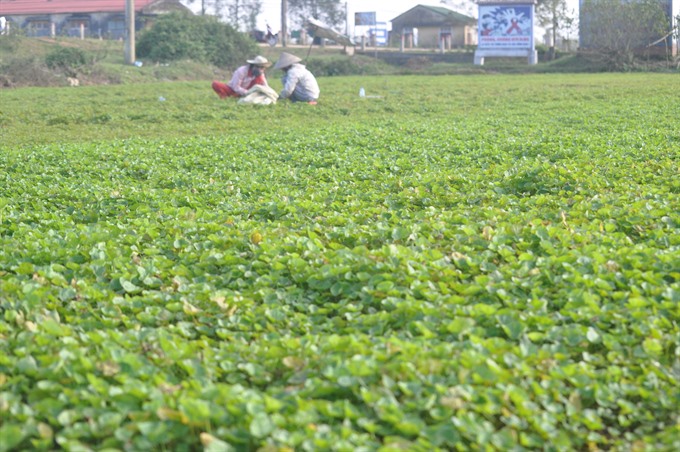 Society
Society

Farmers in central Thừa Thiên-Huế Province are earning good money by growing Gotu Kola, a plant used for daily meals as vegetable and an ingredient in herbal medicine, commercially.
 |
| Farmers havest Gotu Kola in a field in Quảng Thọ Commune. — VNS Photo Phước Bửu |
Phước Bửu
THỪA THIÊN-HUẾ — Farmers in the central province of Thừa Thiên-Huế are earning good money by growing Gotu Kola, a plant used for daily meals as vegetable and an ingredient in herbal medicine, commercially.
A decade ago, farmers in the lowland Quảng Thọ Commune in the province’s Quảng Điền District began planting Gotu Kola to replace rice and common vegetables, including sweet potato, which were giving them low yields.
According to Nguyễn Lương Trí, chairman of the cooperative producing Gotu Kola in the commune, locals earlier harvested wild Gotu Kola only for their own meals until they found the plant was not abundant in nature and quite expensive in the local markets.
The plant was, however, much in demand among the locals, not only for meals, but also to create a homemade drink for lower temperature, as well as to be boiled and used for bathing children to reduce itchy skin and pimples.
Trí said locals started growing the wild plant on their soil. After a few years, the demand for Gotu Kola increased in the local markets, accruing good profits to the growers. The number of growers also increased.
A report by the district’s Agriculture and Rural Development Division said the commune has 45ha growing the plant, and Quảng Thành, another commune, had also started growing the plant in recent years.
A hectare of the plant yields five tonnes of Gotu Kola in one cutting. The plant grows again after it is cut, and local farmers can cut it 10 times a year. The quantity yields an annual income of VNĐ300 million per hectare to the local farmers, much higher than rice.
Trần Đình Nam of the division said there are some 200 families in Quảng Thọ growing Gotu Kola, and nearly 90 per cent of the farmers are growing the plant under Vietnamese Good Agriculture Practice (VietGAP) since 2010 to meet the demand of organic consumers.
Local farmers said they planned to expand the area for this plant. Nguyễn Thị Xí, a Gotu Kola farmer in the commune, said she wanted to double the area of 0.3ha to meet the increasing need. “The plant earns my family an income that is sufficient for three school-going children. We are no longer poor,” she said.
Nguyễn Thị Loan, another grower, said the plant does not require as much manpower as to grow rice, and so, she planned to increase the area.
Trí of the cooperative said the green Gotu Kola produced by local farmers is consumed daily by traders in the province, the nearby provinces of Quảng Bình, Quảng Trị and Đà Nẵng, and the neighbouring countries of Lao and Cambodia.
Since 2015, the cooperative began producing Gotu Kola tea by grilling, drying and packaging the green plant, using industrial machines.
According to Trí, the tea is approved by the Ministry of Health for circulation in the market as a type of supplementary food.
He said the high consumption need in the market, as well as the demand from tea making factories, have helped the cooperative to purchase all the plant products produced by local farmers, giving them a sound income of at least VNĐ50 million to VNĐ150 million a year, depending on the area.
“With a by chance beginning, locals have obtained a decent life with the plant today,” he said. — VNS




